.jpg) The USS Coronado (AGF-11) underway, after her 3 inch guns were removed in 1992. |
| History |
 United States United States |
| Name: |
Coronado |
| Namesake: |
City of Coronado |
| Operator: |
United States Navy |
| Ordered: |
15 May 1964 |
| Builder: |
Lockheed Shipbuilding |
| Laid down: |
3 May 1965 |
| Launched: |
30 July 1966 |
| Commissioned: |
23 May 1970 |
| Decommissioned: |
30 September 2006 |
| Renamed: |
USS Coronado (LPD-11) |
| Refit: |
1980 (Conversion from LPD to AGF) |
| Homeport: |
NAVSTA San Diego, California, U.S. |
| Motto: |
Semper Ductor (Always a Leader) |
| Nickname(s): |
"Building 11" |
| Fate: |
Sunk as part of live-fire exercise Valiant Shield 2012.[1][2] |
| Status: |
3045 fathoms deep at 11°32′6″N 144°31′52″E / 11.53500°N 144.53111°E / 11.53500; 144.53111 |
| Badge: |
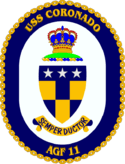 |
| General characteristics |
| Class and type: |
Austin-class amphibious transport dock |
| Displacement: |
16,405 tons full, 10,878 tons light, 5,527 tons dead |
| Length: |
173.4 m (569 ft) overall, 167 m (548 ft) waterline |
| Beam: |
32.9 m (108 ft) extreme, 25.6 m (84 ft) waterline |
| Draught: |
6.7 m (22 ft) maximum, 7 m (23 ft) limit |
| Propulsion: |
steam |
| Speed: |
21 knots |
| Complement: |
106 officers, 1247 enlisted |
USS Coronado (AGF-11) (originally LPD-11) was the second ship of the United States Navy to be named after the city of the same name in the U.S. state of California. She was designed as an Austin-class amphibious transport dock (LPD), one of seven fitted with an additional superstructure level for command ship duties. The ship was launched on 1 July 1966, commissioned 23 May 1970, and became the most advanced command ship in the world. The ship was the first combatant ship in the United States Navy to integrate women as full-time crew members.[3]
Coronado was decommissioned on 30 September 2006, was used for target practice during Valiant Shield 2012 exercises, and was sunk in the Marianas Island Range Complex on 12 September 2012.[4]
History
The Coronado's keel was laid down on 1 May 1965 by the Lockheed Shipbuilding and Construction Company of Seattle, Washington. She was launched on 1 July 1966. After two years of labor shortages and a 12-month strike, she was commissioned 23 May 1970.
First assigned to the U.S. Atlantic Fleet in the 1970s, Coronado conducted extensive operations, deploying on numerous occasions to the Caribbean Sea and Mediterranean Sea, as well as northern Europe.
In 1980, the Coronado was re-designated an Auxiliary Command Ship (AGF-11). Her first assignment was to relieve the La Salle (AGF-3) as command ship for Commander, U.S. Middle East Force, stationed in the Persian Gulf.
Reassigned in October 1985, the Coronado relieved Puget Sound (AD-38) as the command ship of Commander, U.S. Sixth Fleet. During a ten-month tour with the Sixth Fleet, Coronado operated out of Gaeta, Italy, participating in operations in the Gulf of Sidra and strikes against Libyan terrorist support facilities.
In July 1986, the Coronado was relieved as Sixth Fleet command ship and ordered to Pearl Harbor, Hawaii, to become the command ship for Commander, U.S. 3rd Fleet. The admiral and his staff embarked on board Coronado in November 1986. Subsequently, Coronado was relieved as Third Fleet command ship and deployed to the Persian Gulf to assume duties as command ship for Commander, U.S. Middle East Force in January 1988. During this period she served as flagship for Operation Praying Mantis, the largest American naval action since World War II.
Upon her return to Pearl Harbor on 9 November 1988, Coronado again assumed her duties as Commander, U.S. Third Fleet command ship.
The USS Coronado remained homeported in Hawaii until August 1991, when crew and staff changed homeports to San Diego.
On 28 February 1994, the USS Coronado became the first combatant ship in the United States Navy to embark women as part of its regular, full-time crew.[1]
Since then, Third Fleet and Coronado had become the center for naval innovation and technology experimentation. In November 1998 a large ship modification was completed. Incorporating the latest network-centric technology, Coronado became the most advanced command ship in the world.
Sea-Based Battle Lab
In October 2001, the Office of the Secretary of the Navy assigned Coronado to host the Navy's Sea-Based Battle Lab (SBBL), an afloat platform for testing prototype systems and software, evaluating future naval capabilities, and assessing operational compatibility and possible further implementation throughout the United States Navy.
Recent developments in technology have spawned significant advances in naval warfare capabilities. Wireless and Web-based tools, along with new weapon systems, have enabled naval forces to conduct precision operations with greater synchronization, expedience, and potency. With over 16,000 square feet (1,500 m2) of reconfigurable command space and one of the world's most advanced naval C4I suites, SBBL offers a unique shipboard environment that facilitates the evaluation of research for maritime and joint operations.
The Third Fleet J9 Directorate was responsible for managing the SBBL. Partnered with other services, national laboratories, academia, and industry, the Third Fleet staff developed joint exercises and experiments for evaluating the following in an operational environment:
- JTF Command Center organization and configuration
- Tactics, techniques, and procedures
- Naval and joint doctrine
- Biometrics (human feature recognition)
- Wireless applications
- Knowledge management
- Web-based applications
- Logistics
- Humanitarian assistance/disaster relief
The staff and crew provided an unbiased evaluation of the proposal's viability and functionality. Promising, mature initiatives are endorsed for advancement into the beta testing cycle on board the next deploying carrier battle group (or amphibious ready group) and/or into the acquisition process.
Decommissioning and disposal
Late 2003 saw a see-saw change for the Coronado. In November it was decommissioned, transferred to the Military Sealift Command and redesignated T-AGF-11. However, it was concluded shortly thereafter that the operations the ship engaged in required it to be a warship and thus it was transferred back to the Navy and recommissioned, but kept a large civilian complement within the crew from the MSC. In 2004, the 7th Fleet command ship, USS Blue Ridge (LCC-19), went into dry dock and Coronado temporarily assumed 7th Fleet command responsibilities. On 27 September 2004, Blue Ridge returned to duty as the command ship.
Coronado was decommissioned at the end of Fiscal Year 2006.
On 12 September 2012, the Coronado was sunk by a number of warships, and now serves as an artificial reef for the Marianas region.[1][2] The ship now rests 3045 fathoms deep at coordinates 11°32′6″N 144°31′52″E / 11.53500°N 144.53111°E / 11.53500; 144.53111.
Commanding Officers
Commanding Officers of the USS Coronado (LPD-11)/(AGF-11)[5]
| Order |
Name |
Eventual Flag Rank |
Picture |
Assumed Command |
Relieved |
| 1 | Grant Joseph Walker | |  | 23 May 1970 | 13 August 1971 |
| 2 | Sylvester Robert Foley, Jr. | ADM | 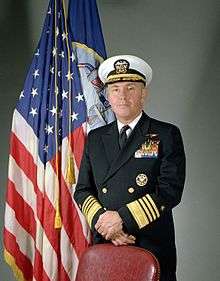 | 13 August 1971 | 30 May 1972 |
| 3 | Martin Jerome Twite, Jr. | | | 30 May 1972 | 2 June 1974 |
| 4 | Eric Neil Fenno | | 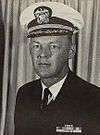 | 2 June 1974 | 20 August 1975 |
| 5 | James Madison Snyder | | | 26 August 1975 | 26 May 1976 |
| 6 | Robert Joseph Ianucci | | | 26 May 1976 | 4 June 1976 |
| 7 | Georges E. Le Blanc Jr. | | | 4 June 1976 | 11 November 1977 |
| 8 | Thomas Paul Scott | | | 11 November 1977 | 1 June 1979 |
| 9 | Denis Thomas Schwaab | RADM | | 1 June 1979 | 13 December 1980 |
| 10 | Harry Patrick Kober, Jr. | | 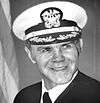 | 13 December 1980 | 19 December 1981 |
| 11 | David Ervin Buck | |  | 19 December 1981 | 6 December 1982 |
| 12 | Robert Harvey Fergussen | | | 6 December 1982 | 1 June 1984 |
| 13 | Earle Godfrey Schweizer Jr. | |  | 1 June 1984 | 23 September 1986 |
| 14 | John Baptiste LaPlante | VADM |  | 23 September 1986 | 25 April 1988 |
| 15 | Robert Charles Williamson, Jr. | RADM | 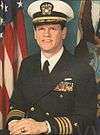 | 25 April 1988 | 1 July 1989 |
| 16 | Richard Claggett Williams III | | | 1 July 1989 | 1 August 1991 |
| 17 | Richard Jerome Nibe | RADM |  | 1 August 1991 | 3 April 1993 |
| 18 | Thomas Francis Noonan | | 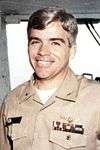 | 3 April 1993 | 30 July 1994 |
| 19 | Isaac Eugene Richardson III | RADM | | 30 July 1994 | 13 December 1995 |
| 20 | Michael Harold Miller | VADM | 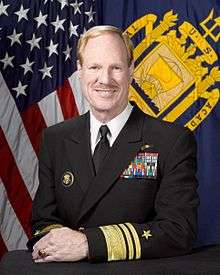 | 13 December 1995 | 16 June 1997 |
| 21 | Thomas J. Ross | |  | 16 June 1997 | 11 December 1998 |
| 22 | James Allen McDonell | |  | 11 December 1998 | 7 January 2000 |
| 23 | Wade Carl Tallman | | | 7 January 2000 | 3 May 2001 |
| 24 | Ted Nelson (Twig) Branch | VADM | 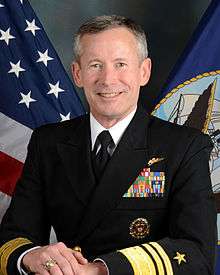 | 3 May 2001 | 23 August 2002 |
| 25 | Kevin Michael Donegan | RADM |  | 23 August 2002 | 14 November 2003 |
| 26 | Kerry J. Porterfield (Military Sealift Command) | | | 14 November 2003 | 19 February 2004 |
| 27 | Christopher David Noble | | | 19 February 2004 | 25 February 2005 |
Gallery
| Historic Images of the USS Coronado |
|---|
| Flagships USS La Salle (Left) and Coronado (right) moored in Bahrain in 1980. Coronado was relieving LaSalle as the flagship for the Commander, Middle East Force (now called United States Naval Forces Central Command). Due to the nature of U.S. flagships individually covering large geographic areas, it was a rare occurrence for both ships to be in the same port. |
| USS Coronado (left) participates in underway replenishment with USS John A. Moore on 1 April 1988. |
| USS Coronado (AGF-11), left, the nuclear-powered strategic missile submarine USS Ohio, center, and the guided missile cruiser USS Worden lie tied up at the Pearl Harbor Naval Station, 1 January 1989. |
| A close-up view of twin Mark 33, 3″/50 caliber gun guns aboard Coronado. These guns were removed from the ship in 1992. |
| USS Coronado, Commander Third Fleet flagship, is assisted by the large harbor tugs Neodesha (YTB-815) and Waxahachie (YTB-814) as she departs Pearl Harbor during RIMPAC "98, 20 July 1998. US Navy photo # 980720-N-2619S-002 by PH2 August Sigur. |
| USS Coronado at Seattle, WA., 4 August 1999. US Navy photo # 990804-N-6939. |
| USS Coronado enters the Port of Yokosuka, Japan to substitute USS Blue Ridge as 7th Fleet flagship while Blue Ridge completes a scheduled maintenance period. Date: 24 March 2004 |
| USS Coronado enters the Port of Yokosuka, Japan to substitute USS Blue Ridge as 7th Fleet flagship while Blue Ridge completes a scheduled maintenance period. Date: 24 March 2004 |
| USS Coronado enters the Port of Yokosuka, Japan to substitute USS Blue Ridge as 7th Fleet flagship while Blue Ridge completes a scheduled maintenance period. Date: 24 March 2004 |
| USS Coronado begins its approach alongside the Military Sealift Command Ship (MSC) underway replenishment oiler USNS Tippecanoe (T-AO 199) to conduct a replenishment-at-sea on 20 April 2004. |
| USS Coronado alongside the Military Command Ship (MSC) underway replenishment oiler USNS Tippecanoe (T-AO 199) to conduct a replenishment-at-sea while underway in the Pacific Ocean on 20 April 2004 |
| Captain Chris Noble, commanding officer USS Coronado, greets the Philippine press shortly after arriving at the former U.S. Navy base on 23 April 2004. |
| Lt. Cmdr. Romelda Sadiarin giving a tour of USS Coronado to students from the Philippine Navy's Naval Education and Training Command. Coronado was making a scheduled port visit.The ship was serving as the temporary command ship for U.S. Seventh Fleet while USS Blue Ridge was in a scheduled dry dock maintenance period. April 2004. |
| USS Coronado sits in Shimoda Bay, in full dress ship on 14 May 2004. |
| Commanding officer of USS Coronado, Capt. Chris Noble, presents Commander, U.S. Seventh Fleet, Vice Adm. Jonathan W. Greenert, with the Admiral’s pendant prior to disembarking the ship and reestablishing his staff aboard USS Blue Ridge during a change-of-flagship ceremony aboard Coronado. |
| USS Coronado moored pierside Naval Base Point Loma, San Diego, CA. during her decommissioning and transition to MSC ceremony, 25 February 2005. US Navy photo by Larry E. Crutchfield. |
| Ex-USS Coronado being towed out of Pearl Harbor by USNS Salvor (T-ARS-52), 17 August 2012, en route to being disposed via SINKEX near Guam the following month. |
| The former USS Coronado being bombed during a live-fire exercise on 12 September 2012. |
|
References
External links
Official website
.jpg)

















_-_Ainsworth_(FF-1090)_and_Bigelow_(DD-942)_at_Bahrain_1981.jpg)


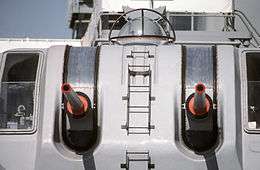


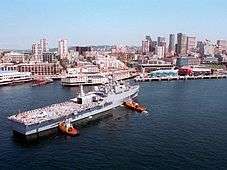
_tours_the_Joint_Air_Operation_Center_aboard_the_U.S._Third_Fleet_command_ship.jpg)
_enters_the_Port_of_Yokosuka%2C_Japan.jpg)
_arrives_at_Fleet_Activities_Yokosuka%2C_Japan.jpg)
_arrives_at_Fleet_Activities_Yokosuka%2C_Japan.jpg)
_begins_its_approach_alongside_the_Military_Sealift_Command_Ship_(MSC)_underway_replenishment_oiler_USNS_Tippecanoe_(T-AO_199).jpg)
_pulls_alongside_the_Military_Command_Ship_(MSC)_underway_replenishment_oiler_USNS_Tippecanoe_(T-AO_199).jpg)
%2C_greets_the_Philippine_press_shortly_after_arriving_at_the_former_U.S._Navy_base.jpg)
_to_students_from_the_Philippine_Navy's_Naval_Education_and_Training_Command.jpg)
_sits_in_Shimoda_Bay%2C_in_full_dress_ship.jpg)
%2C_Capt._Chris_Noble%2C_presents_Commander%2C_U.S._Seventh_Fleet%2C_Vice_Adm._Jonathan_W._Greenert%2C_with_the_Admiral%5Ersquo%2Cs_pendant_prior_to_disembarking_the_ship.jpg)


_bombed_by_B-52_in_2012.jpg)